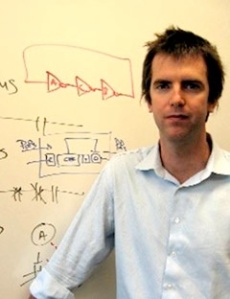The October issue of Esquire magazine is remarkable. Not for the world’s first e-ink cover (appearing on limited special editions of the magazine). But because three of the five scientists featured amongst the seventy-five most influential people of the twenty first century are synthetic biologists…
Forget the recent poll suggesting most people don’t know their synbio from their streptococcus. Esquire has seen the future, and the future is, well, synthetic!
Let me explain. I don’t often purchase Esquire magazine—in fact this may be the first time I have picked up a copy. But what caught my eye in Barnes and Noble this evening was the use of electronic ink (e-ink) on the cover—apparently a world first…
Now, I have a soft spot for e-ink. If you’ve seen the movie “Children of Men” or read Neal Stephenson’s “The Diamond Age,” you will be familiar with the concept—print on paper that changes at the flick of a switch. The concept is beguiling; the elegance of the printed page, with the convenience of a digital display.
Today’s e-ink still has some way to go before it matches the sci-fi dream. But by using microscopically small black and white charged particles, the company E Ink is revolutionizing low power print-realistic displays that give traditional paper and ink a run for its money. Sony Reader® and Amazon Kindle digital books already use the technology, which thanks to micro-engineering is improving all the time. And now we have the first magazine cover that matches what could preciously only be achieved using digital special effects in movies.
Taken to its limits, this is a truly cool technology that could well transform the way information is displayed over the next decade, while slashing the power drain normally associated with digital displays—clean, green, and very sexy!
But not as sexy as synthetic biology.
Having purchased the magazine (the e-ink marketing ploy worked a dream on me), I started browsing through the seventy-five people featured as being the most influential of the twenty first century. Despite a paucity of scientists in the list, each one I stumbled on seemed to be a synthetic biologist—Jay Keasling, Drew Endy, Craig Venter. And of the two remaining scientists, Anthony Atalia—renowned for his work in regenerative medicine—is up to his elbows in biological manipulation. (The fifth scientist listed was Lisa Randall—flying the flag for physics).
This is really quite incredible. Despite low public awareness of synthetic biology, the folks at Esquire clearly see this convergence between biology and engineering as the wave of the future.
What we are quite possibly seeing is the synthetic biologist emerging as the new physicist in the popular role of science-personified: Step aside Einstein and Hawking; big physics is so twentieth century (with all due respect to the Large Hadron Collider). The twenty first century belongs to the likes of Keasling, Endy and Venter—brave new biologists for a brave new world.
Physics clearly still has a part to play—the small particles that make e-ink work for instance definitely have sex-appeal. But let’s face it—in the twenty first century, synthetic biologists are sexier!


Hi there! I’d forgotten about the e-ink in Diamond Age (I haven’t forgotten how badly Stephenson messed up the story in the last 1/3 of the book). And thanks for the info. on influential synthetic biologists. I’ll try to pick up a copy of the issue (gasp! my first Esquire).
I think that is among the most important information for me.
And i’m happy studying your article. However wanna commentary on some basic things, The site taste is perfect, the articles is in reality nice : D. Good job, cheers